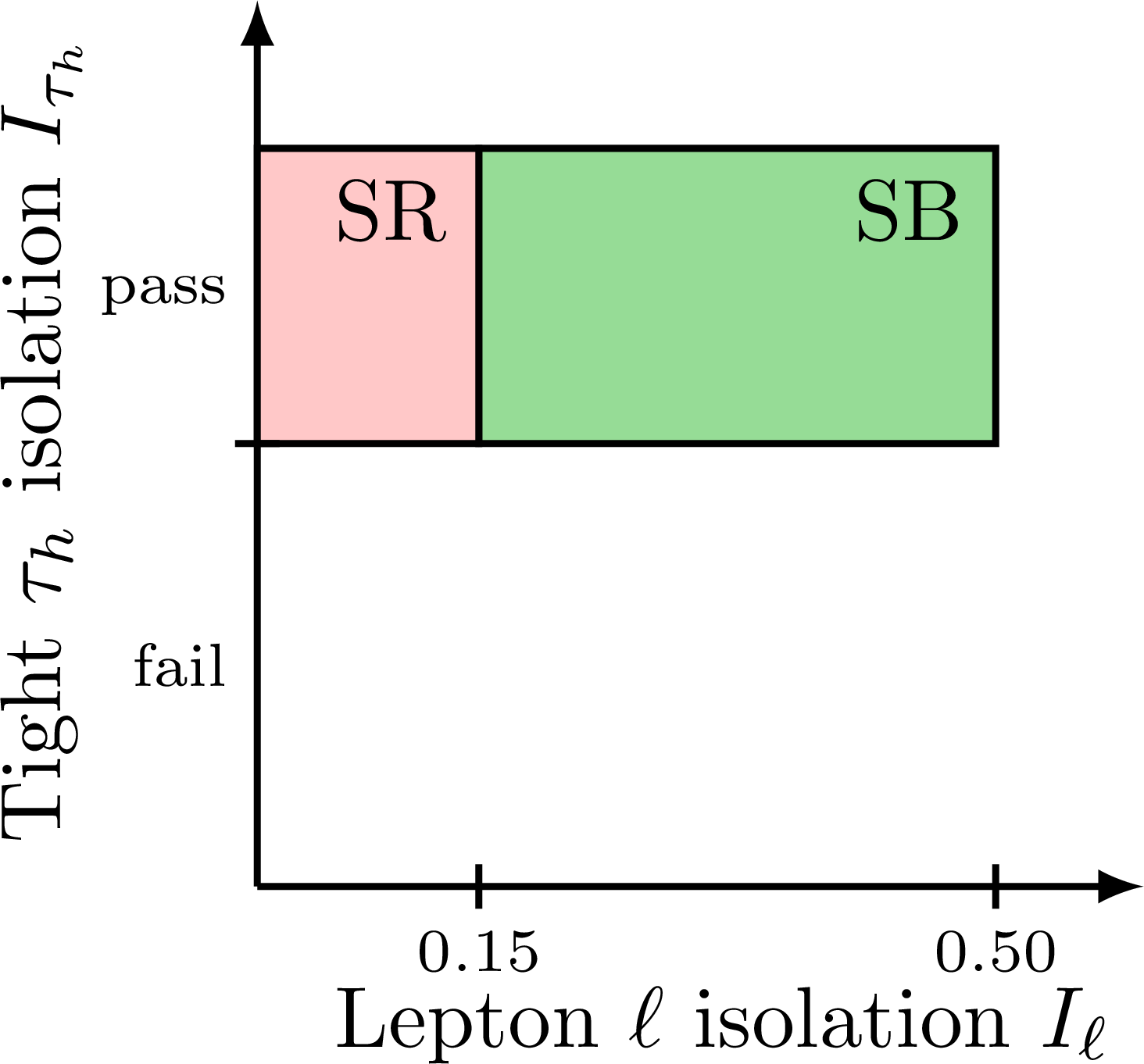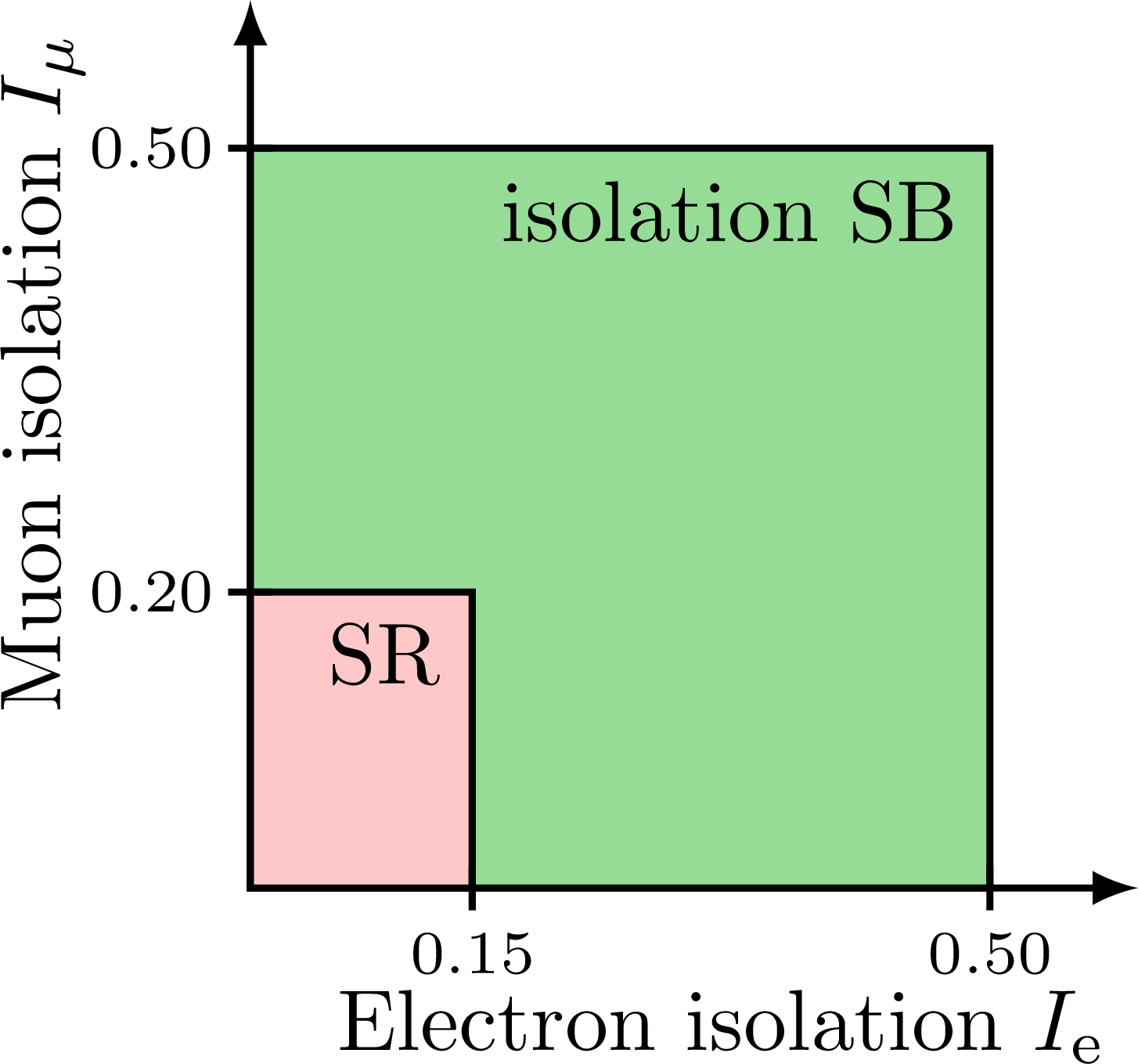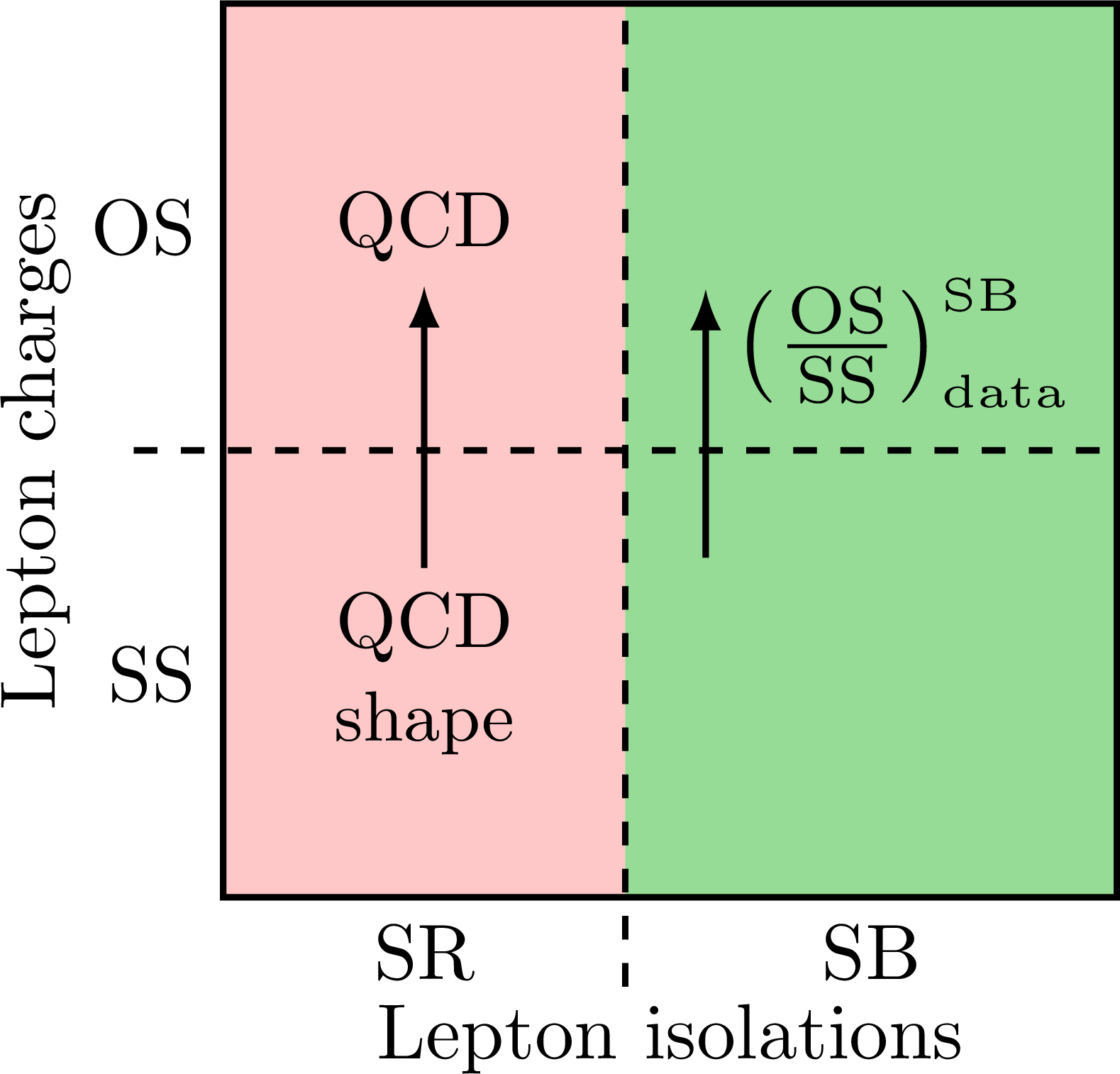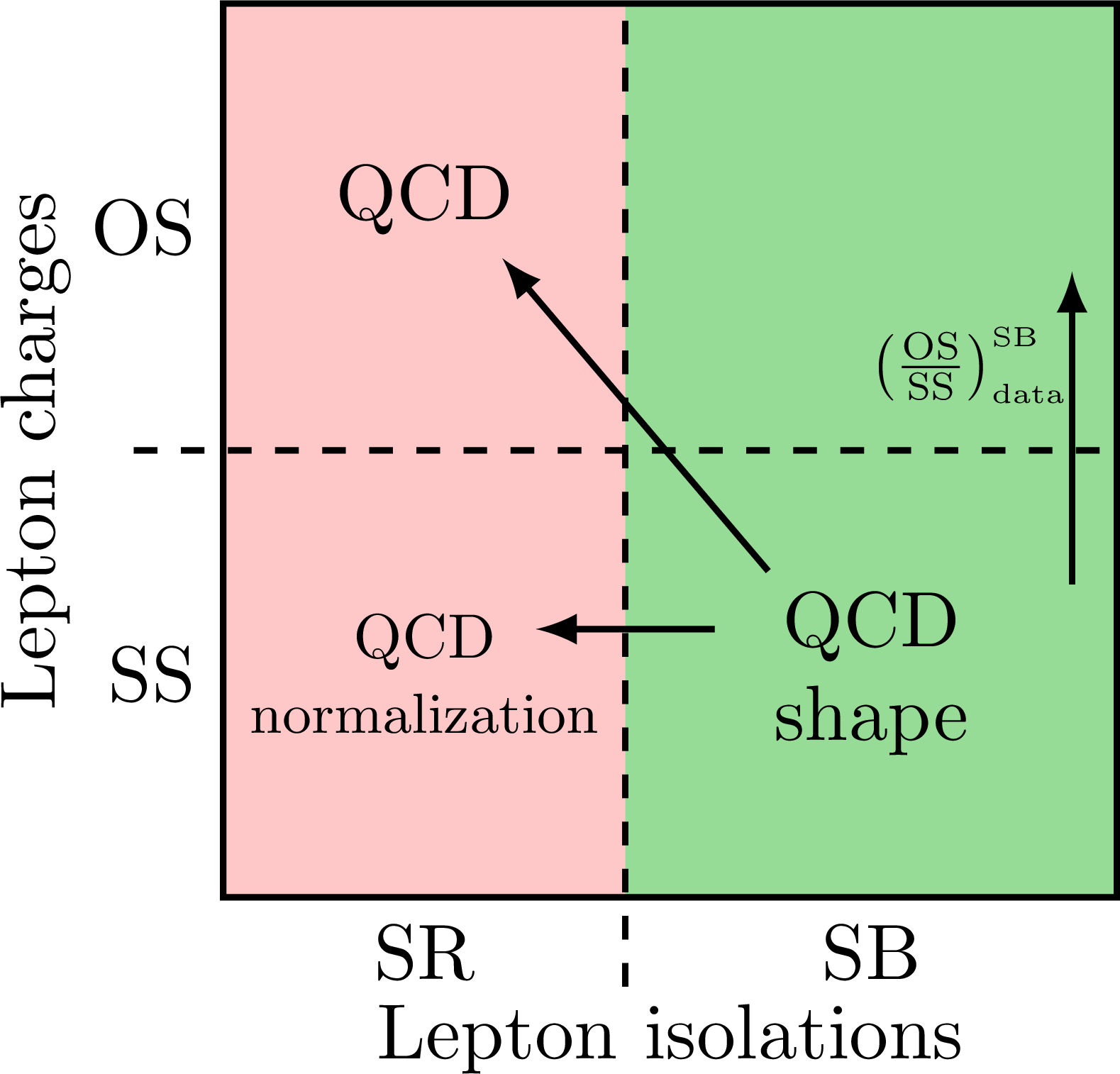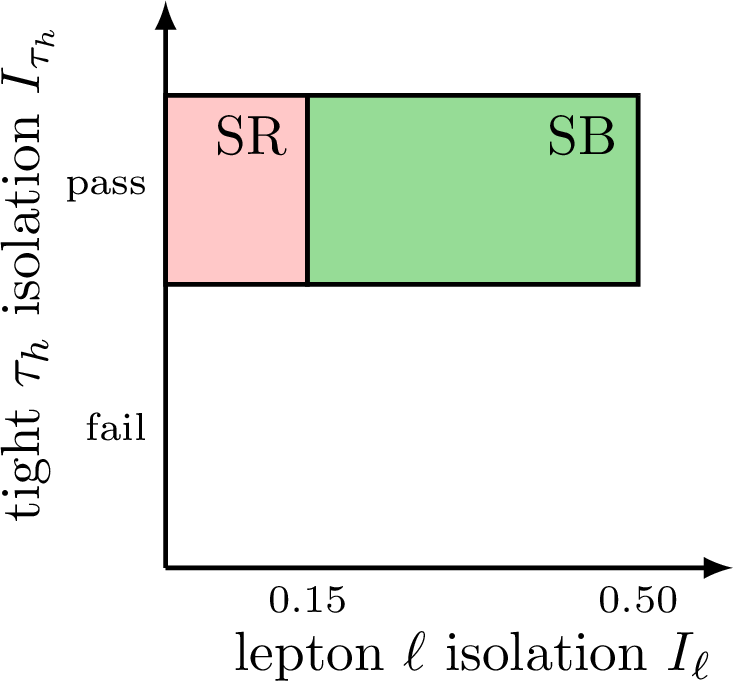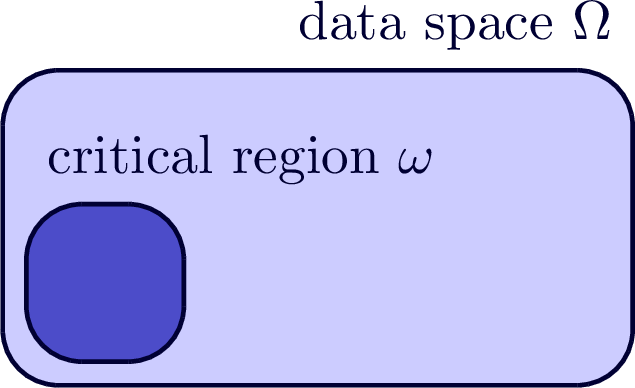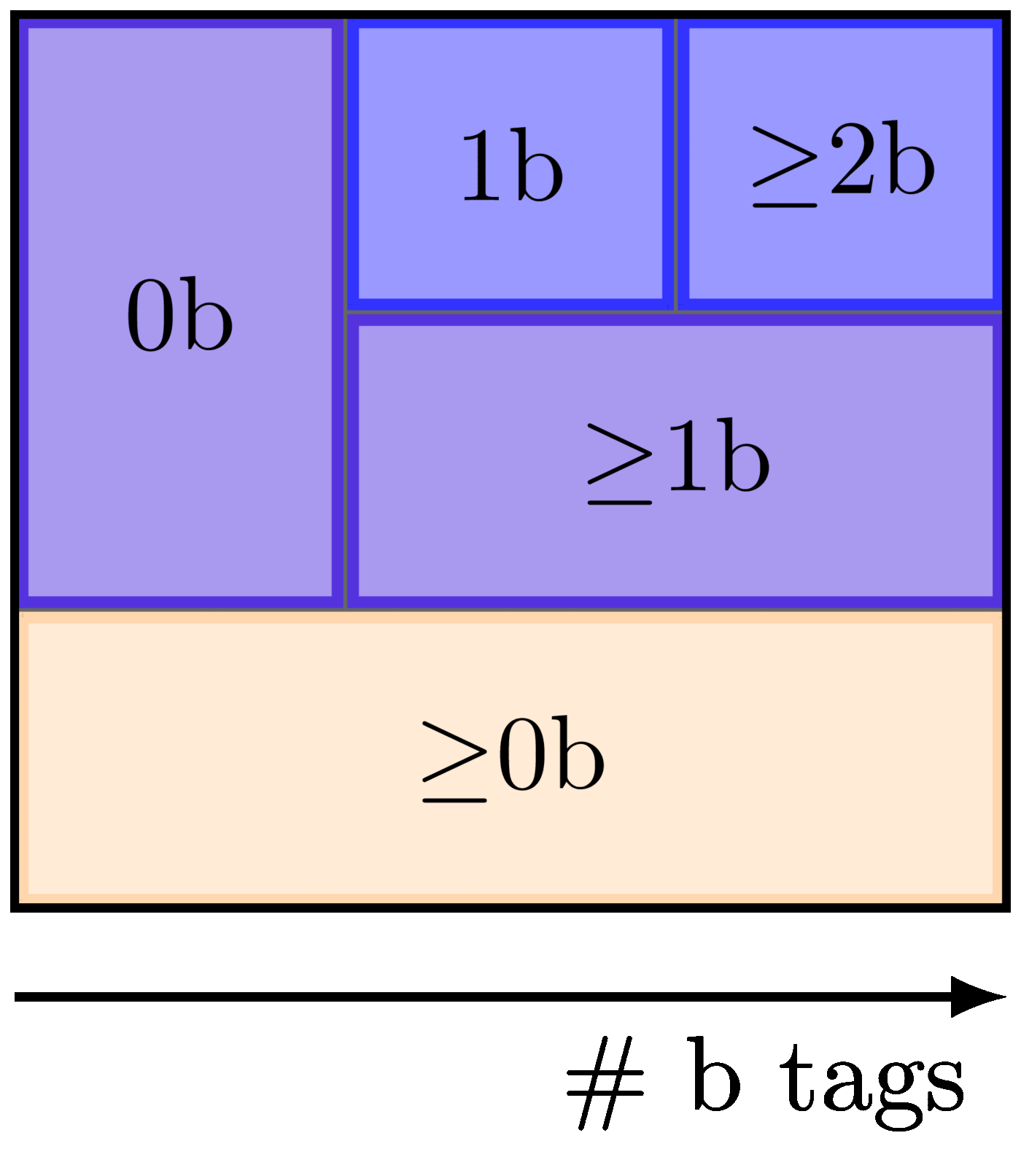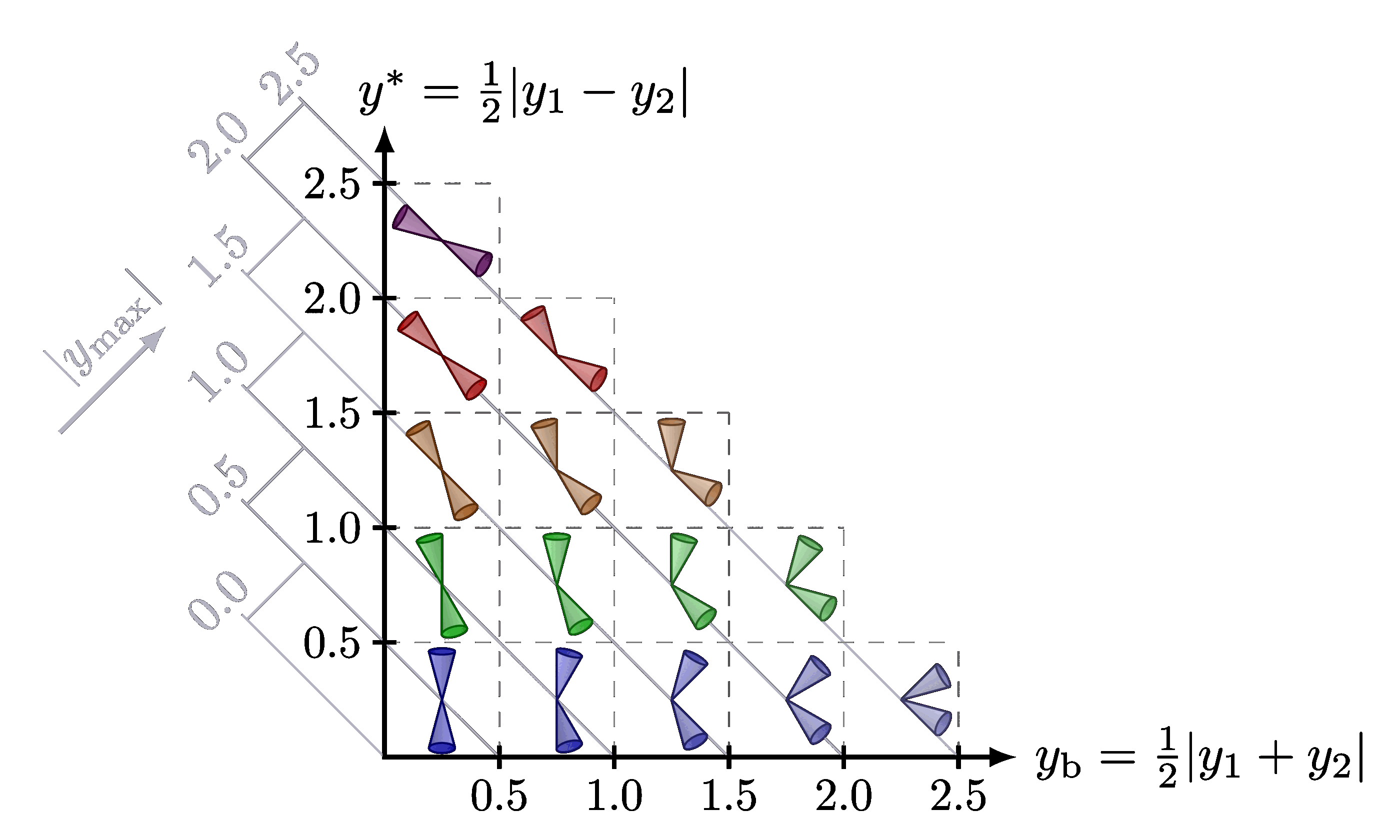Signal and controls regions with isolation sidebands in 2D for analyses of proton-proton collision data. Also see the ABCD method, or event categorization with jets.
Edit and compile if you like:
% Author: Izaak Neutelings (June 2017)
\documentclass{article}
\usepackage{amsmath} % for \text
\usepackage{tikz}
\tikzset{>=latex} % for LaTeX arrow head
\usetikzlibrary{patterns} % for hatches area
% colors
\definecolor{mylightred}{RGB}{255,200,200}
\definecolor{mylightblue}{RGB}{172,188,63}
\definecolor{mylightgreen}{RGB}{150,220,150}
% split figures into pages
\usepackage[active,tightpage]{preview}
\PreviewEnvironment{tikzpicture}
\setlength\PreviewBorder{1pt}%
\def\tick#1#2{\draw[thick] (#1) ++ (#2:0.015) --++ (#2-180:0.03)}
%\def\square#1#2{
% \draw[thick,blue!80,fill=blue!40,line width=1.1]
% (\ex+#1+\ey) rectangle ++(1-2*\ex,1-2*\ey)
% node[black,midway,scale=0.8] {#2};
%}
%\def\rectangle#1#2#3{
% \draw[thick,blue!80,fill=blue!40,line width=1.1]
% (\ex+#1+\ey) rectangle ++(-2*\ex+#2-2*\ey)
% node[black,midway,scale=0.8] {#3};
%}
\begin{document}
% ISOLATION REGIONS 1
\begin{tikzpicture}[scale=6]
% define to change easily
\def\isolep{0.15}
\def\isotau{0.30}
\def\isotauM{0.10} % medium
\def\isotauM{0.10} % loose
\def\isoSB{0.50}
\def\isomax{0.60}
% axes
\draw[->,thick]
(0,0) -- (0,\isomax)
node[at end,left=25pt,rotate=90] {Tight $\tau_h$ isolation $I_{\tau_h}$};
\draw[->,thick]
(0,0) -- (\isomax,0)
node[at end,below=16pt,left] {Lepton $\ell$ isolation $I_\ell$};
% boxes
\draw[thick,fill=mylightgreen]
(\isolep,\isotau) rectangle (\isoSB,\isoSB)
node[anchor=north east] {SB};
\draw[thick,fill=mylightred]
(0,\isotau) rectangle (\isolep,\isoSB)
node[anchor=north east] {SR};
% labels
\draw
(0,\isotau/2) node[anchor=east] {\scriptsize fail}
(0,{\isotau+(\isoSB-\isotau)/2}) node[anchor=east] {\scriptsize pass};
\tick{0,\isotau}{0};
\tick{\isolep,0}{90} node[below=-1] {\scriptsize$\isolep$};
\tick{\isoSB,0}{90} node[below=-1] {\scriptsize$\isoSB$};
\end{tikzpicture}
% ISOLATION REGIONS 2
\begin{tikzpicture}[scale=6]
% define to change easily
\def\isoe{0.15}
\def\isomu{0.20}
\def\isoSB{0.50}
\def\isomax{0.60}
% axes
\draw[->,thick]
(0,0) -- (0,\isomax)
node[at end,left=24pt,rotate=90] {Muon isolation $I_\mu$};
\draw[->,thick]
(0,0) -- (\isomax,0)
node[at end,below=16pt,left] {Electron isolation $I_\text{e}$};
% boxes
\draw[thick,fill=mylightgreen]
(0,0) rectangle (\isoSB,\isoSB)
%(0,\isomu) rectangle (\isoSB,\isoSB)
node[anchor=north east] {isolation SB};
\draw[thick,fill=mylightred]
(0,0) rectangle (\isoe,\isomu)
node[anchor=north east] {SR};
% labels
\tick{0,\isomu}{0} node[left=-2] {\scriptsize$\isomu$};
\tick{0,\isoSB}{0} node[left=-2] {\scriptsize$\isoSB$};
\tick{\isoe,0}{90} node[below=-1] {\scriptsize$\isoe$};
\tick{\isoSB,0}{90} node[below=-1] {\scriptsize$\isoSB$};
\end{tikzpicture}
% CONTROL REGIONS 3
\begin{tikzpicture}[scale=4]
\def\mx{0.45} %middle
% boxes
\fill [mylightred] % SR
(0,0) rectangle (\mx,1);
\fill [mylightgreen] % SB
(\mx,0) rectangle (1,1);
\draw[thick]
(0,0) rectangle (1,1);
% dashed lines
\draw[dashed,thick]
(\mx,-0.1) -- (\mx,1);
\draw[dashed,thick]
(-0.1,0.5) -- (1,0.5);
% labels
\draw
(0,0.75) node[anchor=east] {OS}
(0,0.25) node[anchor=east] {SS}
(\mx/2,0) node[anchor=north] {SR}
(0.5+\mx/2,0) node[anchor=north] {SB}
(0,0.50) node[rotate=90,above=16pt] {Lepton charges}
(0.50,0) node[below=10pt] {Lepton isolations};
\node[align=center,scale=1,inner sep=3] (SB) at (\mx/2,0.25) {QCD\\\small shape};
\node[align=center,scale=1,inner sep=3] (SR) at (\mx/2,0.75) {QCD};
% arrows
\draw[->,thick] % SB: SS -> OS
(SB) -- (SR);
\draw[->,thick] % SB: SS -> OS
(1.2*\mx,0.38) --++ (0,0.3)
node[pos=0.8,right=-1,scale=1.2]{$\left(\frac{\text{OS}}{\text{SS}}\right)^\text{\tiny SB}_\text{\tiny data}$};
\end{tikzpicture}
% CONTROL REGIONS 4
\begin{tikzpicture}[scale=4]
\def\mx{0.45} %middle
% boxes
\fill [mylightred] % SR
(0,0) rectangle (\mx,1);
\fill [mylightgreen] % SB
(\mx,0) rectangle (1,1);
\draw[thick]
(0,0) rectangle (1,1);
% dashed lines
\draw[dashed,thick]
(\mx,-0.1) -- (\mx,1);
\draw[dashed,thick]
(-0.1,0.5) -- (1,0.5);
% labels
\draw
(0,0.75) node[anchor=east] {OS}
(0,0.25) node[anchor=east] {SS}
(\mx/2,0) node[anchor=north] {SR}
(0.5+\mx/2,0) node[anchor=north] {SB}
(0,0.50) node[rotate=90,above=16pt] {Lepton charges}
(0.50,0) node[below=10pt] {Lepton isolations};
\draw
(\mx/2,0.78) node {QCD}
(0.5+\mx/2,0.25) node[align=center] {QCD\\shape} %{$\text{QCD}^\text{SS,SB}_\text{data}$};
(\mx/2,0.25) node[align=center,scale=0.80] {QCD\\\small normalization};
% arrows
\draw[->,thick] % SR: SS -> OS
(\mx+0.1,0.30) -- (\mx-0.1,0.30);
%node[midway,above=8pt,right=-2pt,scale=0.70]{};
\draw[->,thick] % SB: SS -> OS
(0.95,0.35) -- (0.95,0.7)
node[midway,above=8pt,left=-2pt,scale=0.70]{$\left(\frac{\text{OS}}{\text{SS}}\right)^\text{\tiny SB}_\text{\tiny data}$};
\begin{scope}[shift={(\mx+0.02,0.54)},scale=0.35]
\draw[->,thick]
(0.40,-0.5) -- (-0.45,0.5);
%node[midway,above=5pt,right=0pt,scale=0.8]{ $F^{\tiny \text{e}\mu}_\text{\tiny sim}$};
\end{scope}
\end{tikzpicture}
\end{document}Click to download: control_region.tex • control_region.pdf
Open in Overleaf: control_region.tex


